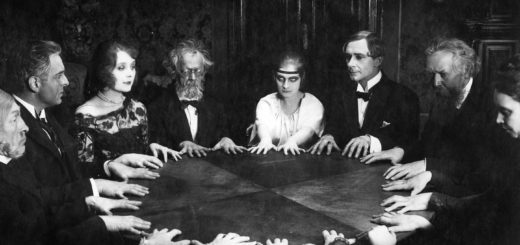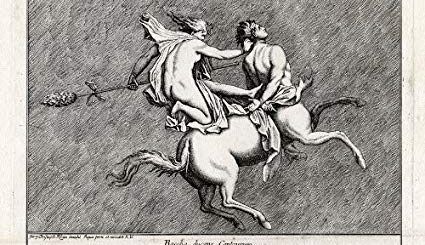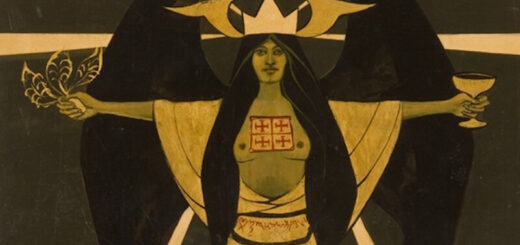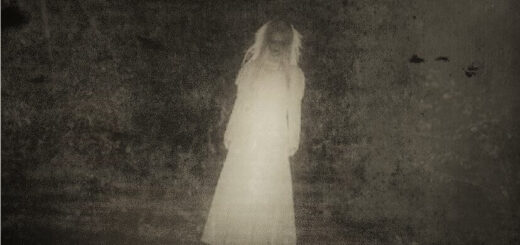The Codex Gigas or Devil’s Bible
According to a legend that was already recorded in the Middle Ages, the scribe of the mysterious Codex Gigas or Devil’s Bible was a monk who broke his monastic vows and was sentenced to be walled up alive. In order to avoid this harsh penalty he promised to create in one night a book to glorify the monastery forever, including all human knowledge.
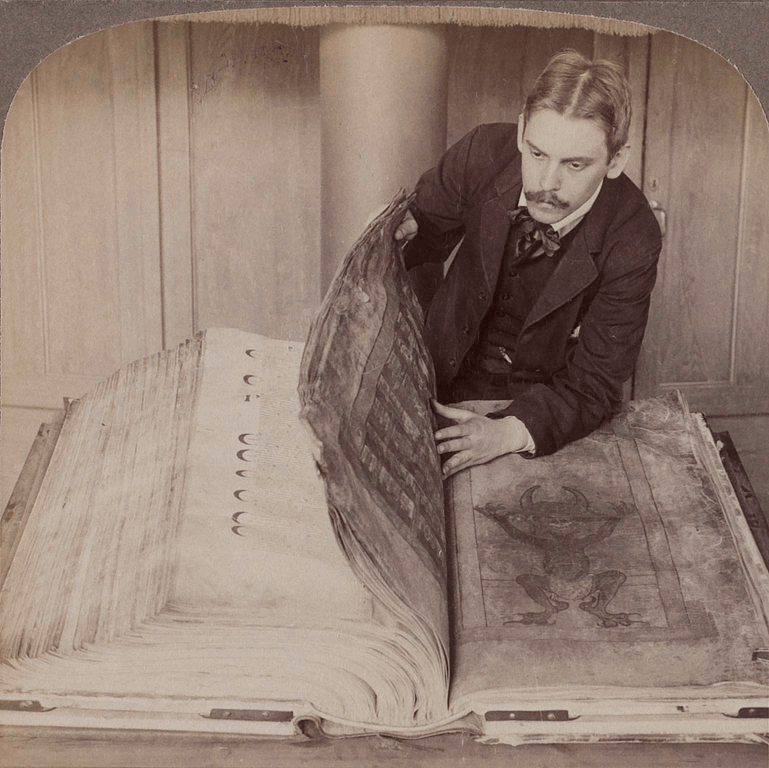
Codex Gigas examined in 1906
Near midnight, he became sure that he could not complete this task alone so he made a special prayer, not addressed to God but to Lucifer, asking him to help him finish the book in exchange for his soul. Lucifer completed the manuscript and the monk added the fallen angel’s picture out of gratitude for his aid. In tests to recreate the work, it is estimated that reproducing only the calligraphy, without the illustrations or embellishments, would have taken five years of non-stop writing. The Codex was said to have been created by Herman the Recluse in the Benedictine monastery of Podlažice near Chrast in the Czech Republic in the early 13th Century. (Records in the codex end in the year 1229.) Handwriting analysis and a credit to Hermann Inclusus – “Herman the Recluse”- indicates the manuscript was indeed the work of a single scribe.

Image of Lucifer in de Codex Gigas
The Codex Gigas is the largest extant medieval illuminated manuscript in the world, at a length of 92 cm (36 in). It is known as the Devil’s Bible because of a very unusual full-page portrait of the devil, and the legend surrounding its creation. It contains the complete Vulgate Bible as well as other popular works, all written in Latin. Between the Old and New Testaments are a selection of other popular medieval reference works: Josephus’s Antiquities of the Jews and De bello iudaico, Isidore of Seville’s encyclopedia Etymologiae, the chronicle of Cosmas of Prague, and medical works; these are an early version of the Ars medicinae compilation of treatises, and two books by Constantine the African.
Eventually finding its way to the imperial library of Rudolf II in Prague, the entire collection was taken as spoils of war by the Swedish in 1648 during the Thirty Years’ War, and the manuscript is now preserved at the National Library of Sweden in Stockholm, where it is on display for the general public.
Measures of the giant book
The Codex Gigas weighs 74.8 kg (165 lb), Codex Gigas is composed of 310 leaves of vellum claimed to be made from the skins of 160 donkeys, or perhaps calfskin, covering 142.6 m2 (1,535 sq ft) in total. It initially contained 320 sheets, though some of these were subsequently removed. It is unknown who removed the pages or for what purpose but it seems likely that they contained the monastic rules of the Benedictines. But in popular fiction, the missing pages have been portrayed as having been deliberately removed, and containing an apocalyptic text known as ‘The Devil’s Prayer’. The book was re-bound in 1819 and its damaged leaves were repaired. The restored manuscript is currently on view at the National Library of Sweden in Stockholm as part of the library’s Treasures exhibit.
The famous picture of the devil in the Codex measures about 50 cm, and directly opposite the devil is a full page depiction of the kingdom of heaven, thus juxtaposing contrasting images of Good and Evil. The devil is shown quite frontally, crouching with arms uplifted in a posture creating a dynamic effect, as if at any moment he could jump up to seize a new victim in his claws. His size is terrifying in itself where he alone fills the entire space of Hell, even though he does not reach up to the tops of the towers.
Several pages before this double spread are written in yellow characters on a blackened parchment and have a very gloomy character, somewhat different from the rest of the codex. The reason for the variation in coloring is that the pages of the codex are of vellum. Vellum, or scraped and dried animal hide, “tans” when exposed to ultraviolet light. Over centuries, the pages that were most frequently turned have developed this tell-tale darker color.
Codex Gigas History
The codex has a unified look as the nature of the writing is unchanged throughout, showing no signs of age, disease or mood on the part of the scribe. This may have led to the belief that the whole book was written in a very short time (see Legend), but scientists are starting to investigate the theory that it took over 20 years to complete. The length, size, and detail of the codex are of such extraordinary magnitude that legend surrounds its origin, specifically the story that it was written by one scribe in one night with help from the devil himself
After the monastery of Podlažice was destroyed in the 15th Century during the Hussite Revolution, the codex was later pledged to the Cistercians Sedlec Monastery and then bought by the Benedictine monastery in Břevnov. From 1477 to 1593, it was kept in the library of a monastery in Broumov until it was taken to Prague in 1594 to form a part of the collections of the Emperor Rudolf II. At the end of the Thirty Years’ War in 1648, the entire collection was taken as war booty by the Swedish army. From 1649 to 2007, the manuscript was kept in the Swedish Royal Library in Stockholm. The site of its creation is marked by a maquette in the town museum of Chrast. On Friday, 7 May 1697, a fierce fire broke out at the royal castle in Stockholm, and the Royal Library suffered very badly. The codex was rescued from the flames by being thrown out of a window. This damaged the binding and knocked loose some pages which are still missing. According to the vicar Johann Erichsons, the codex landed on and injured a bystander. In September 2007, after 359 years, the Codex Gigas returned to Prague on loan from Sweden until January 2008, and was on display at the Czech National Library.
source Wikipedia
VAMzzz Publishing:
 Demonology and Devil-Lore 1
Demonology and Devil-Lore 1
Demonology and Devil Lore 1 & 2 were both published in 1897. Within the demonology scope, this rare and mostly forgotten, almost 1000 pages thick masterpiece, remains unsurpassed in quality and completeness. Even in the 21st century the works offer fascinating missing links for both the academic and student of occult traditions.
Author Moncure Daniel Conway divides Volume 1 in three parts and deals mainly with the evolution and thematic classification of ex-gods, demons and nature creatures. Part 1 offers information about the dawn of dualism, the political degradation of gods into demons due to theological animosity, and the difference between demon and devil. Part 2 examines the demonic realm, according to themes like hunger, heat, cold, the Elements, animals, darkness, dogs, storm, Walpurgis night, cats etc.. Part 3 is focussed extensively on the serpent, dragon, worm, the decline and generalization of demons, and we also encounter the werewolf and basilisk, among much more.
Hardcover Demonology 1
ISBN 9789492355133
490 pages
€ 39,50
Paperback
€ 30,00


